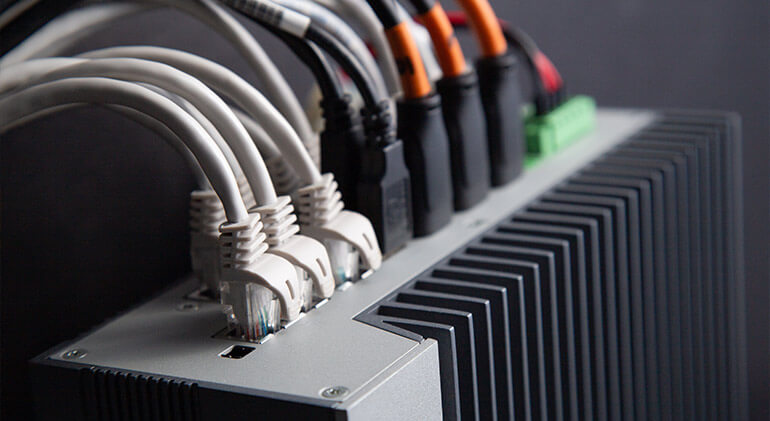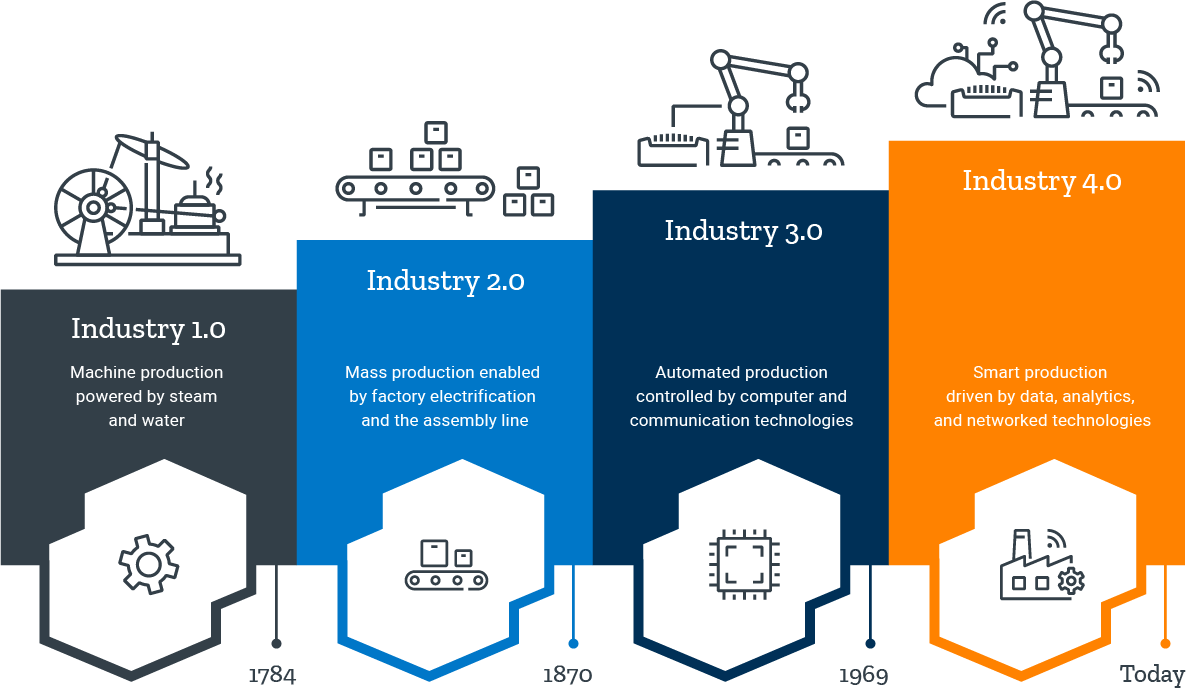Industrial Computing I/O for Industry 4.0
New requirements for I/O in industrial computing have developed with the rise of Industry 4.0. While industrial computing I/O will continue evolving, industry standards have emerged to help companies keep up with the changing demands of Industry 4.0.
What is Industrial Computing I/O?
In this latest industrial revolution, aka Industry 4.0 (see timeline below), industrial computing systems need to be able to receive data (Input) from a variety of sources to process and then transmit (Output) valuable information for real-time decision making, and in some cases, even make those decisions independently. Many companies in their long-term plans, will replace systems and components as needed on an ongoing basis. Therefore, industrial PCs need to be able to support a wide variety of legacy (older) and newer I/O ports for compatibility with the devices through which they receive and transmit data. This post will explain some of the most common industrial I/O, the history behind them, and their current uses in the IIoT (Industrial Internet of Things) realm.
Most Common types of Industrial Computing I/O
Note that this list is not exhaustive – but does represent the ones we see most frequently.
LAN / GbE
For hard-wired high speed connectivity, the standard RJ45 LAN (Local Area Network) port, sometimes also referred to as a NIC (Network Interface Controller) or ethernet port, is the most common form factor. Upload speeds for these ports can range from as little as 100Mbps (megabits per second), to as much as 10Gbps (gigabits per second), which is equivalent to 10,000Mbps. Increasingly, Gigabit Ethernet is the standard that networks are being judged against, with GbE referring generally to networks that support at least 1Gbps speeds.
PoE
PoE, or Power over Ethernet, is a newer variation of the standard LAN port that provides power to devices in addition to data transmission duties. One example of when this is useful is in video surveillance applications. A remote camera can be powered and transmit large amounts of data efficiently through just one cable, and without the need for a power outlet at the camera’s location.
HDMI / DP
HDMI and DisplayPort (DP) connections are the most common high resolution video connections. Both can support up to 4k output as well as digital audio, although the latest versions of each are capable of transmitting 8k (HDMI 2.1) or even 10k (DP 2.0) resolution graphics! The newest version of DP also boasts a maximum 77.4Gbps bandwidth, versus HDMI’s 14.4 Gbps.
VGA / DVI
These are legacy video output connections. Still used in many industrial applications, and offered as a means to continue to use owned display equipment.
USB Type A and Type-C
USB stands for Universal Serial Bus. USB Type A refers to the ubiquitous global computing I/O standard – a rectangular connection with a distinct top and bottom. Its transfer rates can vary from 480 Mbps up to SuperSpeed 10Gbps. USB Type-C is the newest USB connector. Compared to USB Type A, it is smaller, oval, symmetrically shaped and reversible. It was designed to be future proof with SuperSpeed transfer rates up to 20 Gbps. The industrial computing space is just starting to add these connectors to devices and computers. Check out this blog for a full overview of USB A, USB C and the available transfer rates which are referred to as 2.0, 3.0, 3.1 and 3.2.
DIO
Sometimes referred to as General Purpose Input/Output (GPIO), DIO utilizes a logic signal to transfer information. Unlike an analog signal which might be comprised of varying voltages, the digital signals used by DIO have two possible values and are generally represented as either OFF or ON. Think of analog signals as those you might use a knob to set, while digital signals would most often be controlled by a switch. This makes it ideal for sensing switch contacts, reacting to motion sensors, limit switches, operator buttons or machinery status indicators. It can also be used to control indicator lights, small relays or PLCs within equipment. For more information about DIO and isolated versus non-isolated, we have written an overview about DIO.
COM Ports / Serial Ports
The COM port, aka serial port, aka RS232 port, aka IOIOI port, has been around since 1969 and is still supported by every major OS on the market today thanks to its ubiquity. While significantly slower than USB for data transfer, a COM port is a dedicated interface and doesn’t need to be set up with parameters that the OS will recognize upon booting up. DB9 and DB25 are the two variations, with 9 pins and 25 pins respectively. These ports can be configured with different protocols for different purposes – RS232, RS422, or RS485. For its reliability and simplicity, it is a staple of industrial computing I/O and isn’t going away anytime soon.
OnLogic industrial PCs and rugged PCs are highly configurable with a wide range of industrial computing I/O including all options noted above. Let us help you meet your specific I/O needs to keep up with Industry 4.0. Contact our technical sales team today!
Get the Latest Tech Updates
Subscribe to our newsletters to get updates from OnLogic delivered straight to your inbox. News and insights from our team of experts are just a click away. Hit the button to head to our subscription page.
Share
More Articles
OnLogic Industrial Computers
Discover OnLogic's multitude of industrial computers that will help you to advance your IoT project
Learn more at OnLogic.com
OnLogic Industrial PCs: Designed to last. Built to order. Delivered in days. Visit our online store at OnLogic.com






